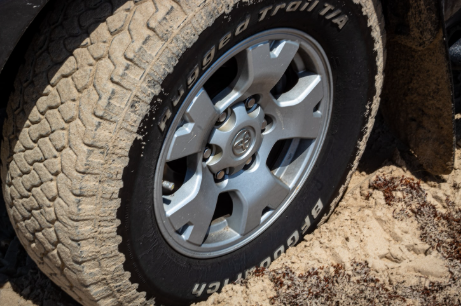Proper Toyota truck tire care keeps you safer as you drive around Kirksville, Missouri, prevents premature replacements, and allows your truck to perform optimally. Read our Toyota truck tire maintenance tips to get the most value from your tires while maintaining the legendary Toyota reliability you've come to expect.
Why Tire Maintenance Is Vital for Toyota Trucks
You demand more from your Toyota truck. You may use your Tacoma or Tundra to haul heavy loads, pull a trailer, or tackle Missouri's mix of city streets and country roads. Good tires directly affect your safety. Neglecting to care for your truck's tires can result in blowouts, especially when towing heavy loads, and reduce your truck's stopping power in emergencies.
Poor wheel alignment can significantly shorten the life span of your truck's tires and decrease fuel efficiency. Missouri weather makes tire care even more crucial, as changing temperatures can dramatically impact tire pressure.
How To Check and Maintain Proper Tire Pressure
The first step in checking the tire pressure is to locate the specifications for your Toyota model. Look for the sticker inside the driver's door or refer to the owner's manual for instructions. Always check the tires when they're cold, meaning your truck has been sitting for at least three hours or you've driven only a short distance.
Use a tire gauge to test all the tires, including the spare. Check the pressure monthly and after significant temperature shifts. Most truck tires should be at around 30 psi. Maintaining even pressure in all the tires ensures they last longer.
Why Tire Rotation Matters
Tire rotation for Toyota trucks is an essential part of maintenance, preventing uneven wear and ensuring balanced handling. Failing to rotate the tires can cause them to wear out quickly, especially if you frequently haul cargo or tow heavy loads. You should plan to rotate the tires every 5,000 to 7,500 miles. You can schedule it with your oil changes to keep it simple.
Your Toyota's drivetrain dictates the best rotation pattern. If you drive a front-wheel-drive vehicle, the front tires move to the back, while the rear tires move forward but on opposite sides. Rear-wheel-drive trucks require a rearward cross: the rear tires go straight forward, while the front tires cross to the back. For an all-wheel-drive truck, follow the same pattern as for a rear-wheel-drive model.
How To Inspect Tire Tread and Spot Uneven Wear
Checking the tread on your Toyota truck's tires ensures your safety. Try the penny test. Stick a penny into the tread with Lincoln's head down. If you can see all of his head, there's not enough tread on the tires, so you need to replace them.
Wear patterns reveal insights into your truck's health. Outer edge wear can indicate underinflation. Wear on one side of the tire may result from alignment issues, improper rotation, or overly heavy loads. Feathered edges that are rough on one side and smooth on the other can mean toe alignment issues. Over-inflation can cause center wear. Cupped or scalloped spots are generally due to a worn suspension or tires that need balancing. Toyota trucks carry heavier loads than cars, so catching these signs early is vital.
Choosing the Right Tires for Your Toyota Truck
Selecting new tires requires understanding what your truck can do and what you need from it. The 2025 Tacoma can tow up to 6,500 pounds and carry a payload of up to 1,709 pounds. These numbers matter because heavier loads require stronger tires. Check the tire sidewall for size, load rating, and speed rating to ensure they match or beat Toyota's specifications.
Different tires serve various needs. All-season tires are well-suited for daily driving and light truck use, while all-terrain tires offer better grip off-road or on construction sites. Look beyond the initial cost for tires. Premium tires may cost more, but they often last longer, saving you money over time.
Alignment and Balancing for Better Handling and Tire Life
Alignment keeps your Toyota's tires straight and prevents early wear. Check the alignment annually or every 6,000 to 10,000 miles if you drive on rough roads. High-performance trucks may require checks every 5,000 miles. Watch for the following warning signs of misalignment:
Your truck pulls to one side.
- The steering wheel sits crooked when you're driving straight.
- The tires show uneven wear.
- The steering wheel shakes at highway speeds.
- The tires squeal during normal turns.
Balancing ensures proper weight distribution in the wheels and tires, stopping vibrations you feel most at highway speeds. Poor alignment can damage steering and suspension components, such as tie rods, ball joints, control arms, and shocks.
Keep Your Toyota Truck Rolling Smoothly
Good tire care enhances safety, saves money, and preserves the Toyota performance you rely on. Regular pressure checks, timely rotations, and professional alignment work together to extend the life span of your truck's tires. Whether you regularly commute to work, haul equipment, or head off on weekend adventures, well-maintained tires form the foundation for confident driving. If you need professional tire service, alignment checks, or advice for how to maintain your Toyota truck, contact our team at Kirksville Motor Company.
close photo of vehicle wheel by Joshua J. Cotten is licensed with Unsplash License



